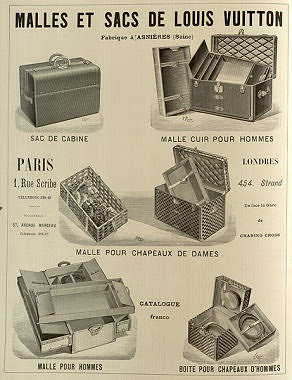Louis Vuitton was born August 4, 1821 in Anchay, in the eastern French region of Jura, the son of a famer and milliner.
Legend has it that the young Louis, a headstrong and wilful child who detested his stepmother (his mother having died when he was ten) left home at the age of 13, on the first day of the year that the weather was good enough to travel.
He walked the almost three hundred miles to Paris, stopping along the way to work and earn food to survive – eventually arriving in the city at the age of 16 in 1837 where he found a job as apprentice to a box-maker producing custom made boxes. Travelling by horse and carriage, trains and boats as they did in those days, meant that luggage was often subjected to being handled roughly, thrown about and generally abused, so a strong trunk or box to protect belongings was essential. Security was also an issue and it was important for the owner to be able to lock his goods away and make sure that it wasn’t easy for thieves to pick the lock.
Louis Vuitton showed enormous talent for his new profession working at the atelier of Monsieur Maréchal who was a well-known box maker of the day. He stayed with the company for 17 years before setting up his own shop in Paris.
Although still a young man, Louis Vuitton’s reputation was such that when Napoleon III married in 1853, his wife to be (Empress Eugenie) hired him as her personal box-maker and packer and commanded him to make boxes that would hold her “beautiful clothes in an exquisite way”. He never looked back. The rich and famous flocked to his store to buy beautiful boxes.
In 1854, the same year he was married, Louis Vuitton opened his own shop in Paris, the sign outside read “Securely packs the most fragile objects. Specializing in packing fashions.”
The shop was hugely successful, orders came in from the rich and famous of Paris and from around the world. His designs were innovative and far ahead of his competitors. He was arguably the father of modern luggage as we know it since it was he who designed a canvas trunk in 1858 to replace the traditional heavy wooden boxes of the day.
The canvas trunks were an immediate commercial success, lighter than boxes, water-resistant and for carriers they were far easier to store, and just a year later Vuitton found it necessary to expand the shop. He opened a workshop in Asnières, northeast of Paris to produce the goods and it is where the company LVMH continues production to this day.
From 1870 to 1871 Louis Vuitton along with many suffered during the Franco-Prussian War, the siege of Paris and then the bloody civil war that destroyed the French Empire.
For Louis Vuitton it meant the destruction of his workshop and shop and the loss of patronage of the previous first family of France. He simply opened a new shop, restored the workshop and began designing and producing more luggage. Just a year later he bought out a new trunk with beige canvas and red stripes. The rich and famous came flocking back and for the next twenty years Louis Vuitton to design and manufacture the most exquisite, luxurious and innovative luggage of the day and beautifully complementing the Belle Époque of Paris at the time.
Louis’ son Georges followed him into the business and in 1886 patented a new lock. So sure were they of the lock’s security features that they challenged Houdini to pick it – he declined. The lock design is still in use today.
Louis Vuitton died aged 70 in 1892, his legacy lives on in the form of the LVMH corporation which has more than 2,400 stores worldwide and remains a leading luxury brand of luggage as well as shoes and accessories.












